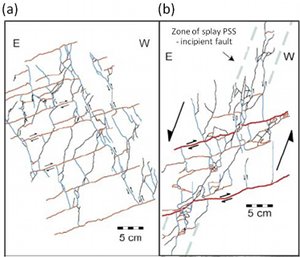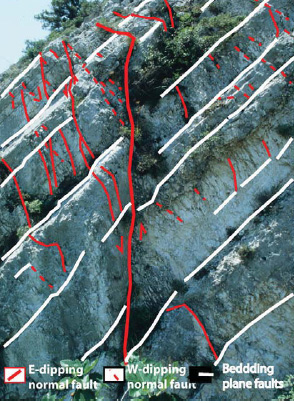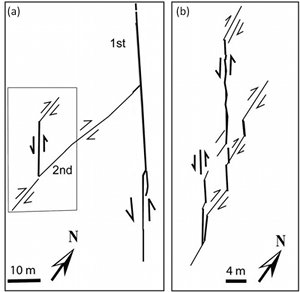| |||||||
|
|
|||||||
|
|
|||||||
| Faulting by Shearing of Orthogonal Sets of Pressure Solution Seams | |||||||
|
As noted earlier, three orthogonal sets of pressure solution seams commonly form the background structures in carbonate rocks in fold and thrust belt environments. Although the appearance of more than three sets of pressure solution seams were reported in the literature, for example, by Alvarez et al. (1978), any set beyond the three fundamental orthogonal sets must have occurred at the expense of shearing of one or more of the initial three sets. We here consider shearing of pairs of orthogonal sets and their products. Consider a pair of bed-parallel (red) and bed-perpendicular (blue) pressure solution sets (Figure 1a) as observed in the platform carbonates of Majella Mountain, Italy. In this case, the bed-perpendicular set trends along the strike of tilted beds. When sheared in response to flexural slip, each of these sets experiences slip sense as shown on the map and results in splay pressure solution seams (black) oblique to both sets as shown. If deformation continued, further shearing utilizes the inclined splay pressure solution seams as well as one or both of the initial orthogonal sets (Figure 1b). The final product is one or two sets of mature faults grown by linkage from one bed level to the next by cataclastic deformation (Figure 2). In case the initial system has two bed-perpendicular orthogonal systems of pressure solution seams in strike and dip directions and both are subjected to shearing as depicted in a highly schematic diagram in Figure 3, then, two shear zones may eventually develop with a dihedral intersection angle (Figure 4), each utilizing the strike- and dip-parallel sheared pressure solution seams and their splays. The sense of shearing may be dictated by longitudinal variation in the amount of transport of thrust sheets. | |||||||
| Reference: |
|||||||
| Alvarez, W. , Engelder, T., Geiser, P.A., 1978 Aydin, A., Antonellini, M., Tondi, E., Agosta, F., 2010 Graham Wall, B., Antonellini, M., Aydin, A., 2003 |
|||||||
|
Readme | About Us | Acknowledgement | How to Cite | Terms of Use | Ⓒ Rock Fracture Knowledgebase |
|||||||



